False Facts About Figs You Thought Were True
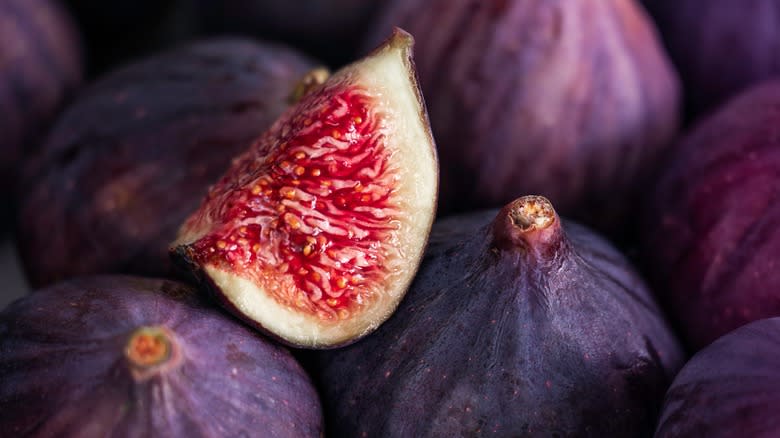
Figs have been around for thousands of years. In fact, they are believed to be one of the first plants to be cultivated by humans. Today, figs play an important part in the diets of many countries around the globe. They can be eaten dried or fresh as a snack or incorporated into a range of dishes, from jams and preserves to baked goods. They also make a great addition to smoothies and salads, imbuing them with a hint of luscious sweetness.
Not only enjoyed for their rich, sweet flavor, figs are also a nutritional powerhouse, which makes them a healthy choice in the kitchen. They are loaded with Vitamin B6 and copper, which improve brain function and aid in the production of blood cells. Figs also contain significant amounts of magnesium, potassium, riboflavin, and thiamine. In addition, raw figs are also relatively low in calories, making them a nutritious snack for those trying to lose weight. Notably, this doesn't hold true for dried figs, which have a higher concentration of sugar. Despite their long history, figs come with their fair share of misinformation. We are here to help you separate fact from fiction, so keep reading!
Read more: Mistakes You're Making With Your Corn On The Cob
Figs Aren't Fruit
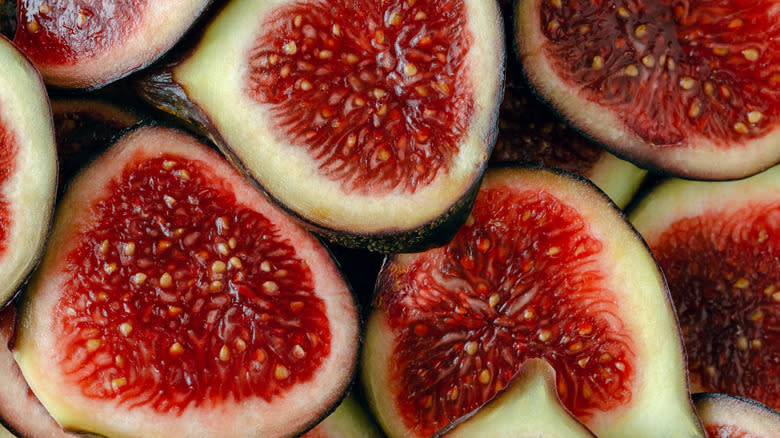
Figs tend to be tricky to classify at first glance due to their distinctive botanical characteristics and appearance. While in the kitchen, figs are commonly regarded as fruits, botany books will actually tell you that they're an infructescence or inverted flowers. This is because the way the fig's structure — or syconium — encloses the seeds and flowers makes it resemble a fruit, meaning that this is precisely what we're eating when enjoying figs rather than fruit flesh.
Although they might not look like your typical fruit, figs certainly don't fall into the category of vegetables. Botanically speaking, a vegetable is "anything that is not the reproductive portion of the plant derived from a flower" (via Taylor & Francis Online). This includes leaves, roots, bulbs, and stems. Since figs are composed of flowers and seeds, they can't be vegetables. Also, since figs taste sweet, they aren't commonly cooked in the same way as vegetables. Interestingly, however, this stands in stark contrast to tomatoes, which, despite being a fruit, are often utilized in savory dishes such as sauces, soups, and stews.
There Are Only A Few Varieties Of Figs

Most of us are only familiar with figs that belong to the "common fig" or Ficus carica family. One of these are Black Mission figs. Purple — not black — on the outside and bright pink inside, Black Mission figs are characterized by their intensely sweet flavor. This makes them a popular addition to desserts and tangy cheeses. Another popular fig type is the Adriatic fig. Sometimes also called white figs, Adriatic figs actually have a light green to light yellow hue. Like Black Mission figs, Adriatic figs are very sweet, which makes them perfect as a snack or in desserts. Just as popular but less sweet, Brown Turkey figs feature a purple exterior and a pale pink interior. Being more subtle in flavor than some other fig varieties, Brown Turkey figs are often used to add a hint of sweetness to salads.
Aside from the fig types commonly found in supermarkets, more than 800 other varieties of the fruit exist around the world. Many of these aren't even grown in the U.S. One of the more notable, and lesser known, fig varieties is the Ronde de Bordeaux fig, which originated in the Bordeaux area of France. Maroon to black in color, Ronde de Bordeaux figs feature flesh that both looks and tastes like plums. Another relatively unknown, yet fascinating, fig type is the strangler fig, which overtakes a host tree, and produces edible fruits that range from delicious to bland in taste.
All Figs Contain A Dead Wasp
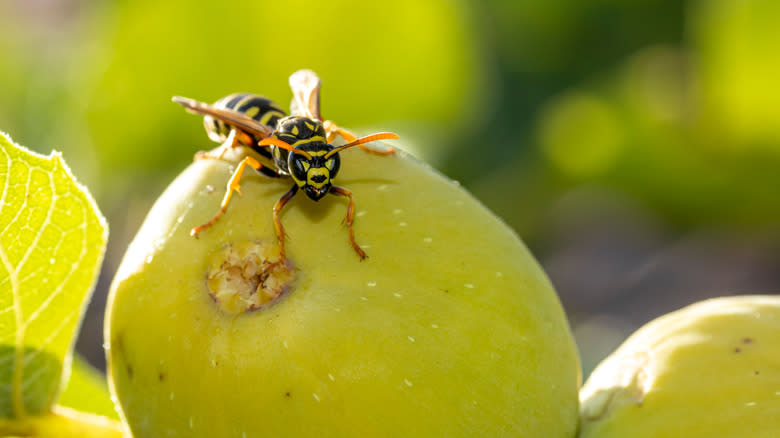
Believe it or not, due to a unique pollination process, some people think that figs aren't vegan. Figs are clearly plants, so why the misconception? It's due to wasps! Specifically, the dead wasp myth comes from the fact that many fig species need to be pollinated by a wasp in order to reproduce. However, the reality is that this just isn't the case for most popular fig fruit sold in the U.S. As reported by California Grown, the five types of figs that are commercially grown in California are self-pollinating and completely wasp-free. Considering that most of the country's figs are grown in the Golden State, you're unlikely to be biting into a wasp anytime soon.
So, what's the deal with figs that depend on wasps to reproduce? Since figs are technically inverted flowers, these little insects need to climb inside the fruit in order for pollination to take place. The process involves a female wasp, which pollinates the flowers (which later turn into seeds), lays eggs inside the fig, and usually dies shortly after. However, this isn't where the story ends. Enzymes inside the fig digest the wasp and turn it into protein. In other words, you're very unlikely to find crunchy wasp parts inside your fig. In fact, anything crunchy inside the fruit are likely to be its seeds.
Figs Are Originally From America
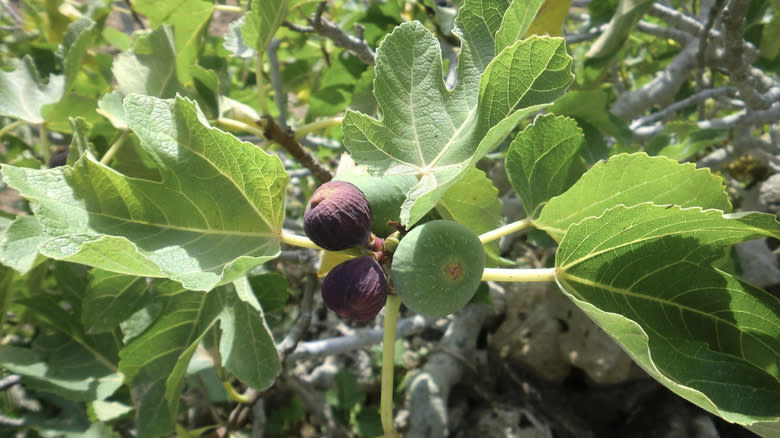
While figs are widely cultivated in California, they're far from being native to the U.S. Instead, figs have a long and rich history that dates back to ancient times. In fact, figs are one of the earliest plants to have been cultivated by humans, way before wheat and legumes. Some of the earliest fig subfossils, dating back some 9,000 B.C., have been found in the Jordan Valley. Figs were also popular in ancient Greece, as attested to by the fig leaf wreath, which was placed around the necks of victorious athletes at the Olympic Games thousands of years ago. Olympic athletes also frequently feasted on figs, believing that they would make them both stronger and faster.
Figs didn't appear in the U.S. until the early 16th century when the fruit was brought to modern-day California by the Spanish Franciscan missionaries. This historical event has given name to the Black Mission fig (also sometimes called Franciscan fig), which is characterized by dark purple skin and sweet flavor. It was around the turn of the 19th century that Californian figs started being produced commercially, with most of the produce sold in a dried form. According to the California Farmland Trust, today the state produces 98% of America's fresh figs and 100% of its dry figs.
Figs Only Grow In Warm Climates

Since figs are native to the Middle East and the Mediterranean, many of us think of them as an exotic fruit. As such, it may come as a surprise that figs are relatively resilient when it comes to cold weather. This said, not all fig types are as hardy as others, with some being better suited to low temperatures. In addition, fig trees planted in the ground — rather than in containers — are less susceptible to the chilly conditions since their roots are more insulated against the cold.
So, how cold is too cold for figs? Even though Black Mission figs bear the most fruit in warm and dry conditions — hence their abundance in California — the plants can withstand temperatures of 10 to 15 degrees Fahrenheit. Other popular fig types in the U.S., such as Brown Turkey figs and Celeste figs, are also frost-hardy, tolerating temperatures as low as 10 degrees Fahrenheit. Perhaps one of the most winter-resistant fig varieties, however, is the aptly named Chicago Hardy, which can endure temperatures of 20 degrees Fahrenheit below zero.
All Figs Must Be Peeled Before Being Eaten
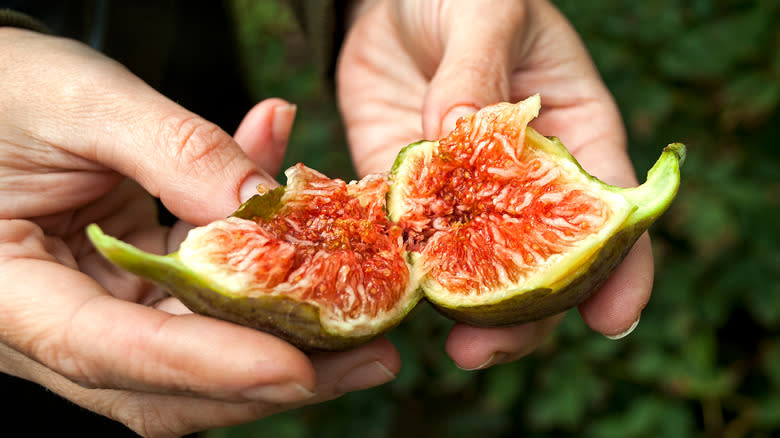
The misconception that figs require peeling likely stems from the fact that they have a relatively thick skin. However, unlike other fruits with a thick outer skin, such as bananas and oranges, the skin of most figs is completely edible. When eating a fig straight off a tree, you can peel it or eat it in its entirety with the skin, seeds, and flesh intact. Just remember to cut off the fruit's stem.
As with everything, there are always exceptions to the rule. Some figs, such as the Calimyrna and Kadota figs, have a bland and relatively thick skin that might be better removed. Whether you need to peel a fig because you don't like the taste or texture of its skin, or for culinary purposes such as making fig jam, the process is relatively easy. Simply twist off the fig's stem and cut an X into its top. Open the fig slightly and use a sharp knife to cut along the four sections of the fruit. Next, use your fingers to peel the skin down until you reach the bottom of the fruit. Finally, cut off the peeled skin and discard it.
Fresh Figs Are Toxic To Pets

It's no secret that fruits that are perfectly safe for humans can be lethal to our four-legged friends. Just for future reference, some of these include raisins, currants, and grapes. However, fig fruits don't fall into this category — provided that they're indeed fresh and your pet doesn't overindulge. In small amounts, fresh figs can be a great source of vitamins A and C, magnesium, iron, and calcium for your pooch or feline companion. To incorporate raw figs into your pet's diet, cut them into bite-size morsels, taking into consideration the size of your furry friend.
Unlike raw figs, dried figs should be completely off limits to your pet. This is because they contain a lot of sugar, which isn't beneficial for animals and can lead to stomach problems. If you grow your own fig plants, it's also important to be aware of the fact that they can be poisonous to dogs. We are talking about all parts of the plant here — leaves, branches, and bark. All of these can cause skin irritations, drooling, and other potentially severe health problems in pets.
There's No Difference Between Figs And Dates
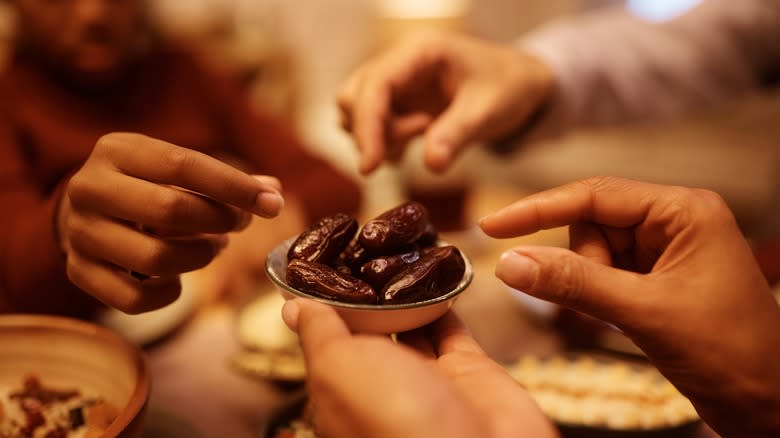
While dates and figs look rather different in their raw form, once dried, they share a number of similar physical characteristics. They're also both sweet and chewy, which may make some people believe that they're indeed the same fruit. One Quora user sums the issue up perfectly, saying, "A fresh fig I wouldn't confuse with a date; but [a] dried fig and a date kind of go together in my mind as those odd fruits my grandma liked but I didn't."
While both figs and dates are rich in nutrients and feature a comparable number of calories, they are completely different fruits with different characteristics. Fresh figs are rounder and fuller in shape than dates, which are more oval (a little like a large raisin). Figs also contain thousands of little seeds, which are responsible for the fruit's crunchy texture. Meanwhile, dates are seedless and feature smooth flesh. In addition, dried figs are much less sticky than dried dates. The two fruits are also different in terms of flavor, with dates being much sweeter than figs. Notably, dates contain 30% more sugar than figs.
You Can't Use Figs In Savory Dishes
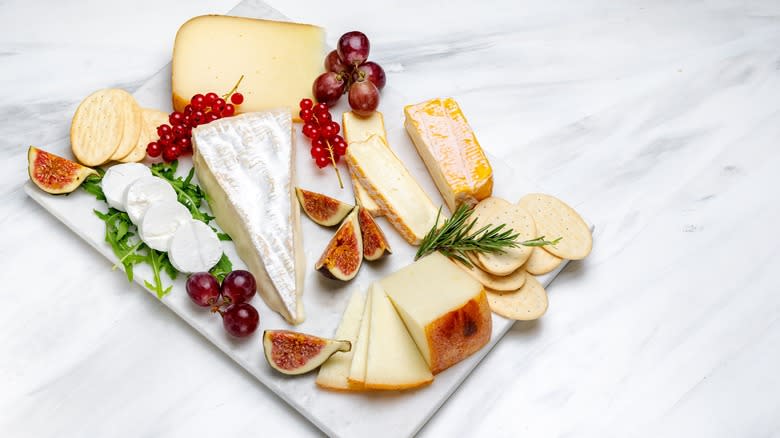
Being naturally sweet, it's little surprise that figs are commonly added to desserts and other sweet dishes such as cakes and tarts. Figs are also frequently used in preserves like jams and marmalades, and make a great addition to smoothies. For instance, to make a fig smoothie, all you need are figs, bananas, your choice of milk, and a little honey.
Figs are far from being a one-trick pony, however. Despite their sweet flavor, figs are also frequently used to elevate savory recipes. Their unique taste and texture make them a great addition to savory foods such as tangy cheeses and cured meats — definitely something to think about next time you're building a charcuterie board. For a breakfast with a twist, try making a fig grilled cheese toast. Perfect with sourdough bread, this simple recipe calls for Gruyère cheese, fig jam, and a little butter. Beyond these culinary treats, figs can also be incorporated into sauces, dressings, and glazes to complement a variety of dishes from roast chicken to grilled steaks.
Freezing Alters The Taste Of Figs
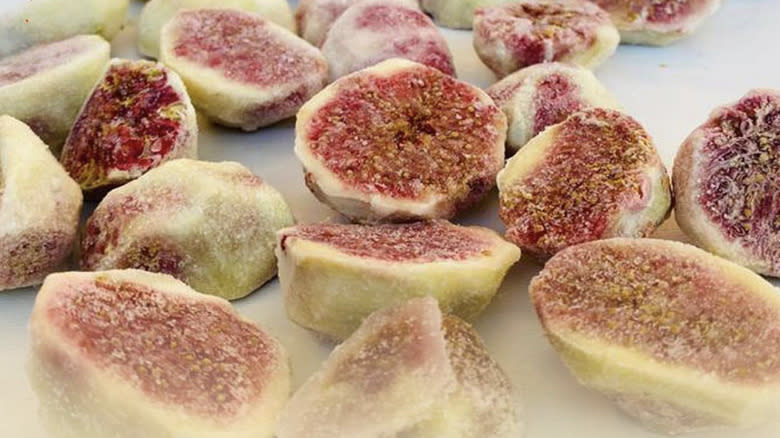
If you end up with more figs than you can handle at the end of the fig season, don't despair. There are several measures you can easily take to stop figs from spoiling. One option is to turn them into jam, and another is to freeze them for later use. While there are some fruits that can lose their flavor in the freezer, such as tomatoes, melons, and cucumbers, figs aren't one of them. While their texture might become slightly more mushy after defrosting, figs will still taste great in sauces, ice creams, and stews. This said, thawed figs might not be the best replacement for recipes that rely on the texture of fresh figs.
Fresh figs have a relatively short lifespan and shouldn't be stored in the refrigerator for longer than three days. Luckily, figs can also be kept in the freezer for up to eight months. To best preserve them, wash the figs in cool water, dry them, remove the stems, and place them up on a baking sheet lined with parchment paper. Feel free to cut the figs into halves, quarters, or smaller pieces to speed up the thawing process later. After the figs are frozen and won't stick together, transfer them into a freezer-safe plastic bag or container. To stop the figs from changing color while frozen, sprinkle them with a little ascorbic acid or lemon juice.
Read the original article on Mashed

